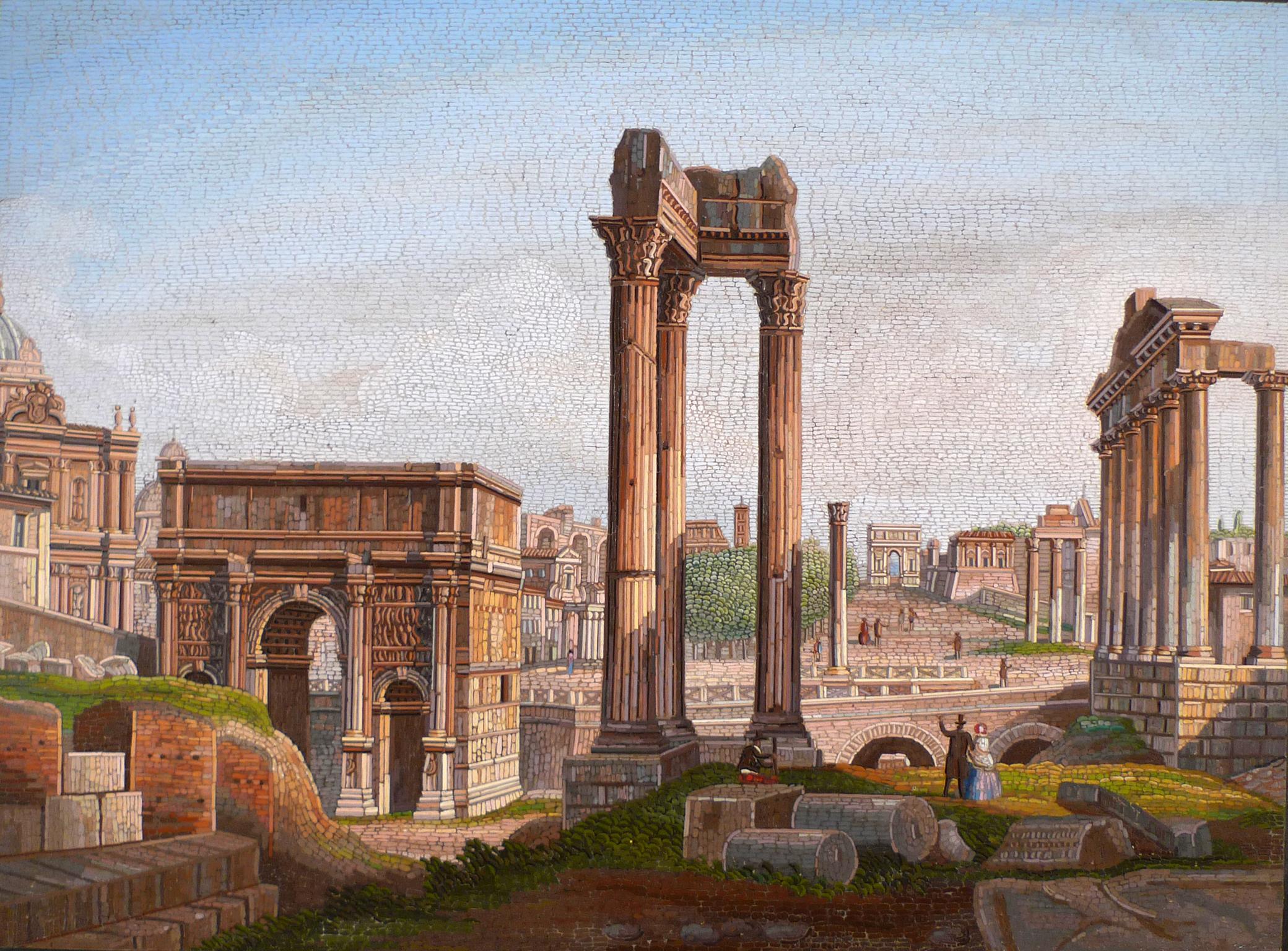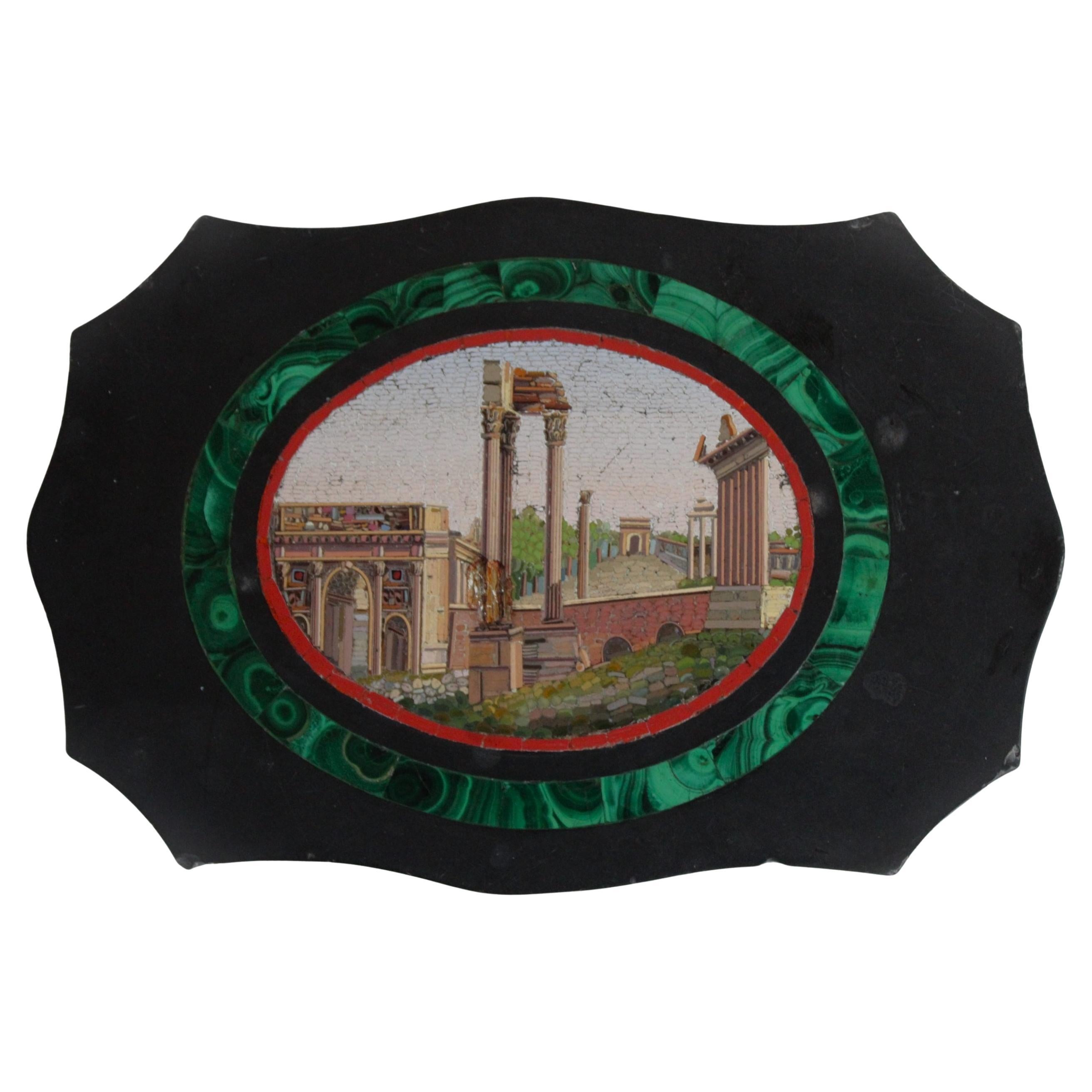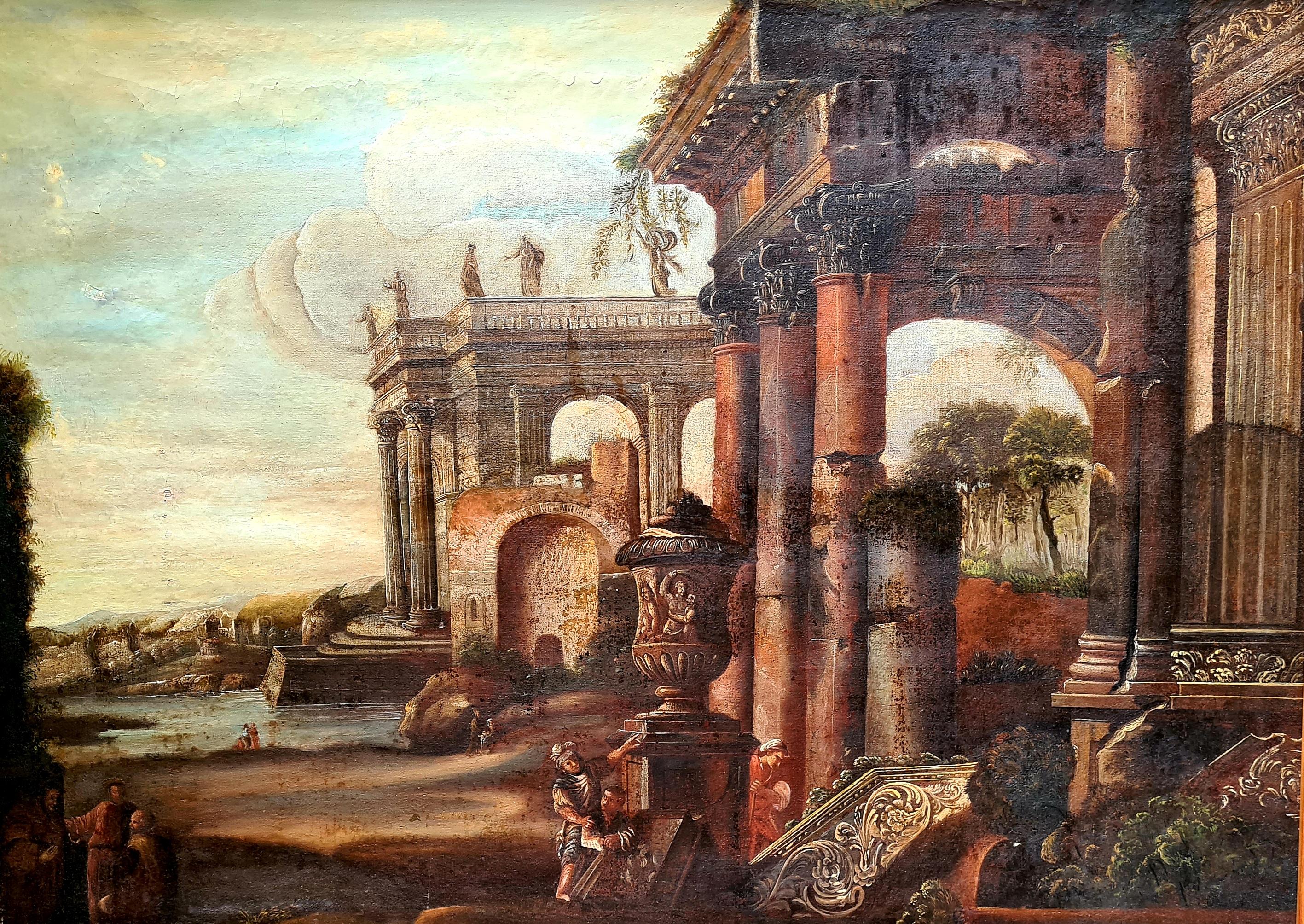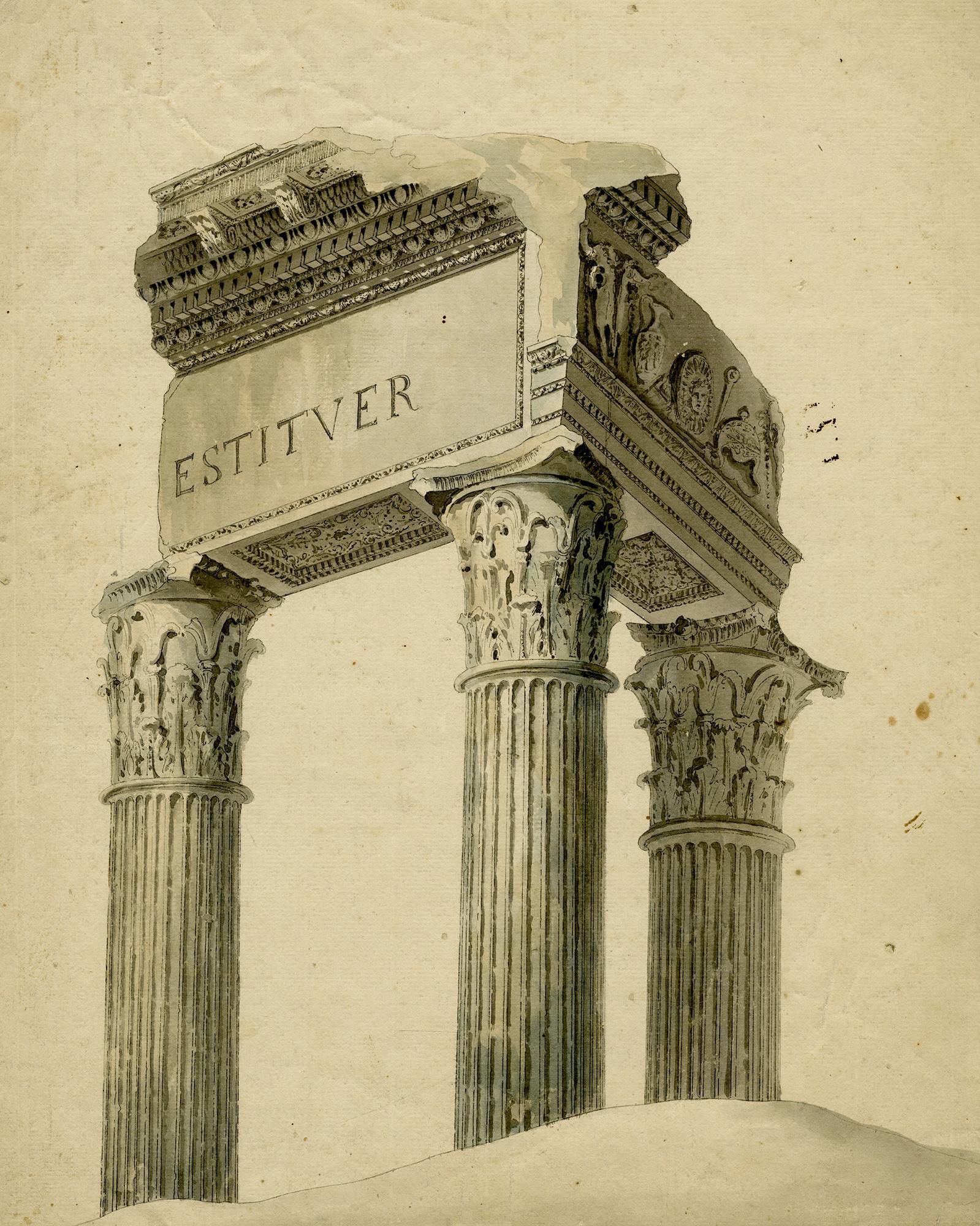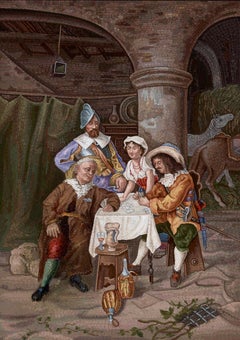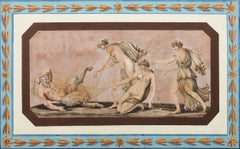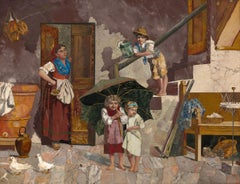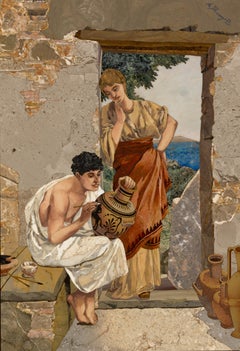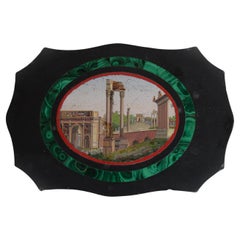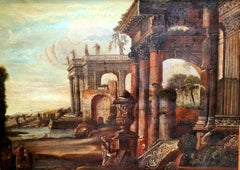Items Similar to Temple of Vespasian and Titus Roman Micromosaic
Want more images or videos?
Request additional images or videos from the seller
1 of 6
UnknownTemple of Vespasian and Titus Roman MicromosaicLate 19th Century
Late 19th Century
$68,500
£52,415.29
€59,989.82
CA$96,740.05
A$105,139.82
CHF 56,345.33
MX$1,276,584.15
NOK 707,381.49
SEK 655,988.82
DKK 448,050.11
About the Item
The ruins of the ancient Roman Temple of Vespasian and Titus are the subject of this Italian micromosaic. Crafted in intricate detail, the scene is composed from hundreds of tiny glass tiles that have been painstakingly chosen and placed to create a painting-like effect. A bucolic landscape surrounds the ruins, lending a sense of romance to the scene that is further enhanced by the presence of a mother and child seated near the temple's columns. It is an extraordinary example of this ancient art form that experienced a surge in popularity in the 18th and 19th centuries.
Vespasian was Roman Emperor from 69 AD to 79 AD and the founder of the Flavian dynasty, which ruled the empire for 25 years. This temple was constructed to honor Vespasian and his older son and successor Titus (ruled 79-81 AD); it was completed by Titus’ brother, Domitian, around 87 AD. Titus and Vespasian were each deified through the ceremony of apotheosis. Thus, tradition dictated that they be honored by Roman citizens and subjects as Roman deities. This imperial worship was as much a sign of allegiance to the emperor of Rome as it was a formal religion.
The temple suffered significant damage during medieval times, particularly circa 1300 under Pope Boniface VIII and in Pope Nicholas V's remodeling of the Forum. All that survives today is the podium's core, parts of the inner chamber, and the three Corinthian columns depicted in this classic micromosaic. The architrave surmounting the capitals display the last few letters of an inscription, [R]ESTITVER[UNT] (meaning "they restored"), commemorating the restoration of the temple by Septimius Severus and his son, Caracalla, around 200 AD.
Late 19th century
Micromosaic: 10 1/2" high x 12 5/8" wide
Frame: 12 1/2" high x 14 3/4" wide
- Creation Year:Late 19th Century
- Dimensions:Height: 12.5 in (31.75 cm)Width: 14.75 in (37.47 cm)Depth: 1.5 in (3.81 cm)
- Medium:
- Period:
- Condition:
- Gallery Location:New Orleans, LA
- Reference Number:Seller: 31-36591stDibs: LU18616405142
About the Seller
5.0
Vetted Professional Seller
Every seller passes strict standards for authenticity and reliability
Established in 1912
1stDibs seller since 2013
20 sales on 1stDibs
Typical response time: 3 hours
- ShippingRetrieving quote...Shipping from: New Orleans, LA
- Return Policy
More From This Seller
View AllGamblers Italian Micromosaic
Located in New Orleans, LA
A friendly game of cards is the subject of this 19th-century Italian micromosaic. A special type of mosaic that uses incredibly small pieces of tesse...
Category
19th Century Other Art Style More Art
Materials
Glass, Mosaic
Italian Panel with Satyr and Nymphs
Located in New Orleans, LA
This extraordinary Italian gouache and oil on canvas brings two of the most popular characters from Greek mythology vividly the life - the nymph and the satyr. Both creatures are famed for their carefree natures and lascivious temperaments, and tales abound of satyrs pursing nubile nymphs in order to rape or seduce them, usually with little success. One such narrative humorously unfolds in the present piece, which depicts an indignant satyr captured by three nymphs with a golden net.
The relationship between these two mythological creatures was a popular one for artists throughout the 18th and 19th centuries, though its origins stretch back to antiquity. Both satyrs and nymphs...
Category
Early 19th Century Other Art Style Figurative Paintings
Materials
Canvas, Oil, Gouache
Price Upon Request
Pietre Dure Plaque Of Village Children
Located in New Orleans, LA
Magnificent and colorful, this enchanting Florentine work of art is not a painting, but upon closer inspection is revealed to be a superb example of the intensive art of pietre dure....
Category
19th Century More Art
Materials
Stone, Marble
Pietre Dure Plaque Of Ancient Artisan By Alberto Menegatti
Located in New Orleans, LA
A young man clad in classical robes paints an amphora vase as an attractive admirer observes him in this magnificent pietre dure plaque by Florentine artisan Alberto Menegatti. The work is emblematic of the charming scenes of rural life that were favored by Italian pietre dure artists. The superlative quality and beauty of the stone specimens utilized to create the composition distinguish this piece, and the artist’s ingenious use of the natural striations and inclusions in his stones allows him to convey texture and shadow to brilliant effect.
The art of pietre dure developed from the ancient art of opus...
Category
Early 20th Century More Art
Materials
Stone
Perseus
Located in New Orleans, LA
The legendary Greek god Perseus is the subject of this elegant half-bust by Ubaldo Gandolfi, a major painter and sculptor from Bologna. The son of Zeus and Danaë, Perseus was the le...
Category
Mid-18th Century Other Art Style Figurative Sculptures
Materials
Terracotta
Clio by Studio of Romanelli
Located in New Orleans, LA
Studio of Raffaello Romanelli
Early 20th Century Italian
Clio
Inscribed "Executé sous la Direction du Prof. Romanelli" (on base)
Marble
Clio, the muse of history from Greek mytho...
Category
Early 20th Century Figurative Sculptures
Materials
Marble
You May Also Like
" Very Fine Italian Micromosaic Plaque", depicting The Roman Forum, Circa 1850
Located in Madrid, ES
THE ROMAN FORUM
19th CENTURY ITALIAN MICROMOSAIC PLAQUE
Circa 1850
Mounted on an 18th Century Carved and Gilt Wood Frame
8-1/2 X 10-7/8 inches (21.3 X 27.5 cm.)
framed: 14-1/4 X 16-...
Category
1850s More Art
Materials
Mosaic
Micro-mosaic Roman Forum
Located in Rome, IT
Micro-mosaic Roman Forum with inlaid frame in malachite. ADDITIONAL PHOTOS, INFORMATION OF THE LOT AND SHIPPING INFORMATION CAN BE REQUEST BY SENDING AN EMAIL
Tags: micro-mosaico Fo...
Category
Mid-20th Century Italian Picture Frames
Materials
Precious Stone
$6,177
Large Grand Tour 18th Century Capriccio Painting Roman Ruins after Gennaro Greco
Located in Cotignac, FR
A fine, large 18th century veduta capriccio scene with temple ruins after Gennaro Greco from the circle of Pietro Cappelli. The painting is presented in a more modern carved gilt woo...
Category
18th Century Baroque Landscape Paintings
Materials
Canvas, Oil
$9,028 Sale Price
20% Off
Roman Ruins
By Joseph Lindon Smith
Located in Milford, NH
A fine watercolor painting of Roman ruins attributed to American artist Joseph Lindon Smith (1863-1950). Smith was born in Pawtucket, Rhode Island and after attending Brown Universit...
Category
Early 20th Century Landscape Drawings and Watercolors
Materials
Paper, Watercolor
$2,500
Ancient Roman Temple - Etching by Various Authors - 18th Century
Located in Roma, IT
Ancient Roman Temple from the series "Antiquities of Herculaneum", is an etching on paper realized by Various Authors in the 18th Century.
Good conditions with folding.
The etching...
Category
18th Century Old Masters Figurative Prints
Materials
Etching
A Grand Tour study of ruins in the Roman Forum - English School, early 19th C.
Located in Middletown, NY
Ink and wash in black ink with pen in black ink on watermarked C & I Honig cream laid paper, 14 7/8 x 12 1/4 inches (378 x 311 mm), the full sheet. In very good condition with some m...
Category
Early 19th Century French School Landscape Drawings and Watercolors
Materials
Handmade Paper, Ink
